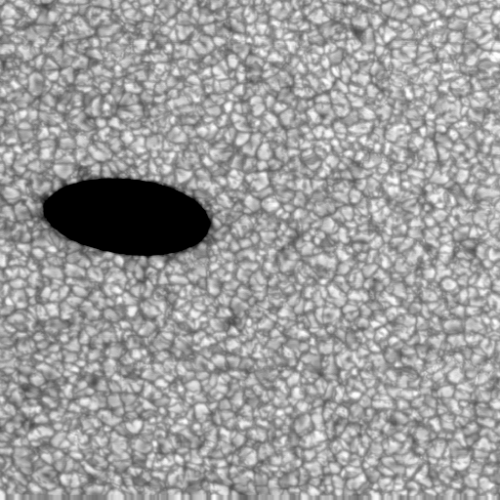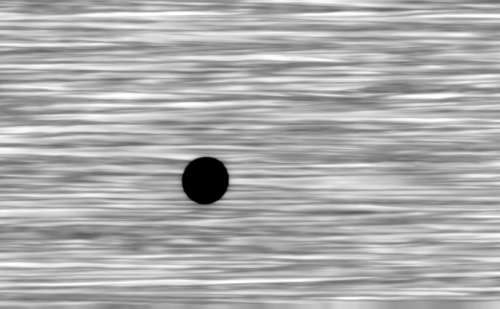Transit of Mercury captured by Hinode
aional Astronomical Observatory of Japan (NAOJ)
Institute of Space and Astronautical Science / Japan Aerospace Exploration Agency (ISAS/JAXA)
National Aeronautics and Space Administration (NASA)
Mercury marched in front of the Sun from 11:11 UT to 18:44 UT on May 9. Hinode, which is on a Sun-synchronous orbit around the Earth, was able to observe this event without atmospheric distortion.
Transit of Mercury captured by the Solar Optical Telescope (SOT)
Because it uses a slit, the spectro-polarimeter of the Solar Optical Telescope (SOT) obtains a one-dimensional vertical image stripe with each exposure. A two-dimensional image can be produced by taking vertical image stripes while moving the slit horizontally little by little between exposures, and then aligning the images. Mercury moves during the time it takes to scan across it using this method. That's why Mercury is elongated sideways in this image. (*1)

Another method is to fix the position of the slit, take images at appropriate intervals as Mercury passes in front of the slit, and then line up the images horizontally. Using this method, Mercury looks like a circle. (*2)

(*1) The granulation pattern in the background is not distorted because the granules don't change shape in the time it takes to scan across each granule. On the other hand, because Mercury is large and moves fast, its position changes noticeably during the time required to scan across it. Therefore Mercury appears elongated sideways.
(*2) In this case, since the slit doesn't move, the background is always the same part of the Sun. The horizontal striped pattern in the background results from placing vertical image stripes of the same location at different times next to one another, stretching each point out into a horizontal line. But the lines are not perfectly parallel because granules appear and disappear within the time required to capture this image.
Transit of Mercury captured by the X-Ray Telescope (XRT)
Credit: NAOJ/JAXA/MSU/SAO
The X-Ray Telescope (XRT) found the shadow of Mercury in coronal X-ray images prior to the first contact.
Transit of Mercury captured by the EUV Imaging Spectrometer (EIS)
Images in the Fe XII spectral line (19.5 nm) (Credit: NAOJ/JAXA)
The EUV Imaging Spectrometer (EIS) found the shadow of Mercury in coronal extreme-ultraviolet (EUV) images prior to the first contact.
Regarding the use of images and movies on the page concerned, please visit the page here. The credits of images and movies on this page are “NAOJ/JAXA” unless explicitly stated to the contrary. Regarding images and movies on this page the credits of which are “NAOJ/JAXA”, "NAOJ/JAXA/MSU", or “NAOJ, JAXA, NASA/MSFC”, terms of use for Copyrighted Works owned by NAOJ can be applied. In using the images and movies, the credits should be given.
